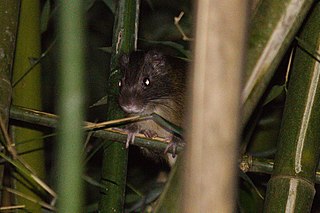
A genet is a member of the genus Genetta, which consists of 17 species of small African carnivorans. The common genet is the only genet present in Europe and occurs in the Iberian Peninsula, Italy and France.
The giant tree-rat is a species in the family Echimyidae, the spiny rats. It is the only species in the monotypic genus Toromys. It is endemic to Brazil, where it occurs in the flooded forest along the banks of the Amazon River and its tributaries.

The Atlantic bamboo rat, or southern bamboo rat, is a spiny rat species found in humid tropical forests in Argentina, Brazil and Paraguay. It is the only member of the genus Kannabateomys.
The tuft-tailed spiny tree rat is a spiny rat species from Brazil south of the Amazon River, where it has been found in grassland and gallery forest. It is the only species in the genus Lonchothrix. Very little is known about this rodent. It is small with an average adult weight of about 138 grams. It is nocturnal and solitary in habits.
Lund's Atlantic tree-rat,, is a spiny rat species found in Brazil.

The dwarf brocket, or chunyi, is a small species of deer native to the Andean highlands in western Bolivia and southeastern Peru, where it is found in forest and páramo. Its pelage is reddish-brown with dark grey foreparts and neck. The underparts are lighter brown, and the muzzle short and thick. It weighs around 11 kg.

The Philippine forest rat is a species of rodent in the family Muridae. It is found only in the Philippines, and is located throughout the archipelago. The scientific name commemorates British colonial administrator and zoological collector Alfred Hart Everett. R. everetti is widespread throughout its range and feeds on a diet of worms and insects. There are no major threats to the species, which has been found to be competitively superior to introduced Rattus species.

Hombron's kingfisher or the blue-capped kingfisher is a species of bird in the family Alcedinidae endemic to the Philippines and found only on Mindanao. It is one of the most colorful kingfishers in the country having a dark blue cap and wings with rufous spots, a striped rufous belly, white chin and red bill. Its natural habitats are on the upper ranges of tropical moist lowland forest and tropical moist montane forests. It is threatened by habitat loss.

The red-crested tree-rat or Santa Marta toro is a species of tree-rat found in the monotypic genus Santamartamys in the family Echimyidae. It is nocturnal and is believed to feed on plant matter, and is mainly rufous, with young specimens having a grey coat. IUCN list the species as critically endangered: it is affected by feral cats, climate change, and the clearing of forest in its potential range in coastal Colombia.
The bare-tailed armored tree-rat is a species of arboreal rodent in the family Echimyidae. It is found in lowland tropical rainforest east of the Andes in Ecuador and Peru.

The Burmese short-tailed shrew is one of three species of shrew in the genus Blarinella. It is in the family Soricidae and is found in China and Myanmar. Its natural habitat is subtropical or tropical dry forests.

The Hun shrew is a species of mammal in the family Soricidae. It is found in Cameroon, Central African Republic, Mali, Democratic Republic of the Congo, and Nigeria. Its natural habitats are tropical or subtropical moist lowland or montane forest, and heavily degraded former forest.

The Ugandan lowland shrew or Moon shrew, is a species of mammal in the family Soricidae. It is found in Kenya and Uganda. Its natural habitats are subtropical or tropical swamps and montane forests.

The tarella shrew is a species of mammal in the family Soricidae. It is found in Democratic Republic of the Congo and Uganda. Its natural habitats are subtropical or tropical moist lowland forest and montane forest.

The long-tailed mole is a species of mole in the family Talpidae. It is found in China, Vietnam and Myanmar.

Grant's forest shrew is a species of mammal in the family Soricidae found in the mountain forests of central Democratic Republic of the Congo, Kenya, Rwanda, Tanzania, and Uganda. Its natural habitat is subtropical or tropical moist montane forests.
Pattonomys is a genus of rodent in the family Echimyidae, named after American mammalogist James L. Patton. It contains the following species:
The grizzled Mexican small-eared shrew is a small mammal in the order Eulipotyphla. It is native to the Sierra Madre Oriental of eastern Mexico. It can be found in dense, wet cloud forest, where it is found in the thick herbaceous undergrowth and leaf litter. It is known to be insectivorous and terrestrial. Threats to the species are deforestation for agriculture and urban development.
The western falanouc is a rare mongoose-like mammal endemic to Madagascar. Until recently, the eastern falanouc was the only recognized species in the genus Eupleres. In 2010, Goodman and Helgen provided morphological evidence showing the two falanoucs are each a separate species and are found in separate geographical locations. E. major is larger and browner compared to E. goudotii and has a diet consisting mainly of invertebrates such as worms, snails, and slugs.












